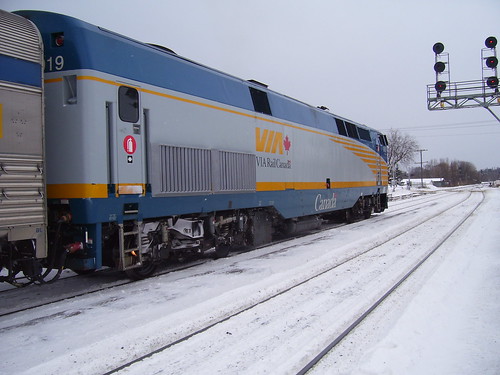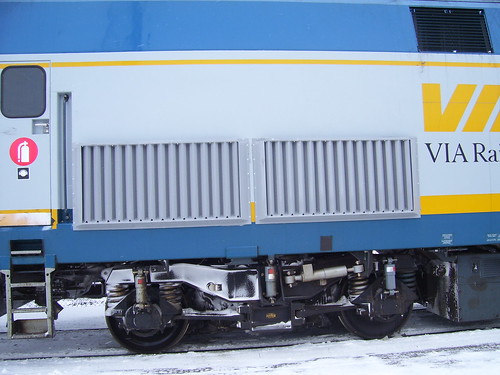Hello all!
Here are two photos I took this past winter (just a few days before Christmas) at the VIA station in Brockville, ON. They're of P42 #919 on Train 57, and I just got around to putting them up online.
Take a look at the vents towards the rear of the locomotive....


(*This page will not allow me to post the full-size images....if you'd like to see the larger version, go to my Flickr page: http://www.flickr.com/photos/timberley512/)
I have not seen vent covers like that on any other P42 before (VIA's or otherwise), and have not seen it since. Even on 919, I have been unable to find other photos that show the vents with those covers.
My questions to all of you are....
1) What are they? My guess is some sort of snow-shields.
2) Why only on 919? Was this another VIA pilot project like the extra headlight that we may see further implementation of (or disappear never to be seen again)?
Thanks.
Here are two photos I took this past winter (just a few days before Christmas) at the VIA station in Brockville, ON. They're of P42 #919 on Train 57, and I just got around to putting them up online.
Take a look at the vents towards the rear of the locomotive....


(*This page will not allow me to post the full-size images....if you'd like to see the larger version, go to my Flickr page: http://www.flickr.com/photos/timberley512/)
I have not seen vent covers like that on any other P42 before (VIA's or otherwise), and have not seen it since. Even on 919, I have been unable to find other photos that show the vents with those covers.
My questions to all of you are....
1) What are they? My guess is some sort of snow-shields.
2) Why only on 919? Was this another VIA pilot project like the extra headlight that we may see further implementation of (or disappear never to be seen again)?
Thanks.
Tim
----------------------------------------------------------------------------------------------------
Can't
Beat
Canadian Railways
---------------------------------------------------------------------------------------------------
----------------------------------------------------------------------------------------------------
Can't
Beat
Canadian Railways
---------------------------------------------------------------------------------------------------